Brick Mortar Repair Mix
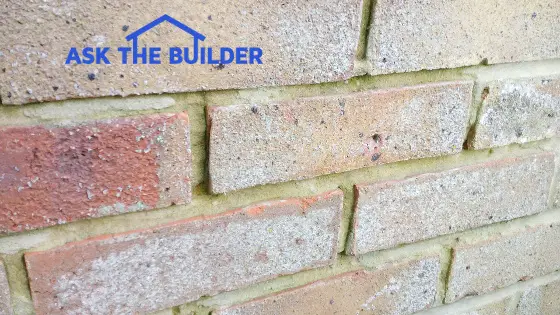
Brick Mortar Repair Mix | The mortar in between these brick was repaired but the mix failed. The workman made at least one mistake. (C) Copyright 2017 Tim Carter
Brick Mortar Repair Mix TIPS
- Use same mortar Romans used to build aqueducts
- Hydrated lime mortar with secret volcanic ash - SEE BELOW links
- WATCH tuck-pointing videos below
- Be careful of amount of water used to mix new mortar
- CLICK HERE to Get Tim's FREE & FUNNY Newsletter
DEAR TIM: It appears I wasted some money five years ago. I had my brick building repointed with new mortar and it has deteriorated quickly.
Do you have any idea what caused it to happen? The building is close to the sea, about 500 yards, and is exposed to a fair degree of salt spray and fog.
What’s the best brick mortar repair mix to use and how would you apply it? Ian L., Brighton, UK
DEAR IAN: It’s always a sad day when I hear stories like this. Money is a precious resource for most people and it’s a shame when a repair that was supposed to last one hundred or more years fails in less than five.
Mortar Ingredients
Let’s discuss what most mortars are made with and then we can perform an autopsy on what caused your tuck pointing failure. Most mortars are a mix of fine or medium sand, a dry powder that almost always contains Portland cement and/or hydrated lime and water. In rare instances a mason may add some sort of liquid bonding agent.
Free & Fast Bids
CLICK HERE to get FREE AND FAST BIDS from local masons who can tuck point your mortar joints.
Add Water - Create Magic Crystals
When water is added to Portland cement, some other bagged mortar mix or hydrated lime, it starts an irreversible chemical reaction called hydration.
Small crystals start to grow as the dry powder mixes with the water. The crystal growth is what causes the mortar mix to transform from a plastic mixture that resembles applesauce into an artificial rock once it’s fully hardened.
Interlocking
The crystals that grow interlock with microscopic cracks and holes in the brick. This is why the mortar is such a great building material as it cements one brick to another creating a solid wall if mixed and placed correctly.
Tuckpointing Mortar Video
Here's a pretty good video that shows the tuck-pointing process. The key is to carefully install the new mortar so you don't smear it on the face of the brick.
Causes Of Failure
Here’s a partial list of what might have caused your failure:
- too much water was used to mix the mortar
- too little mortar mix or Portland cement was used to make the mortar
- the mason re-tempered the mortar by adding additional water to it
- rain pelted the fresh mortar before it had a chance to harden
- hot and windy weather sucked the water from the fresh mortar too fast
Any one, or a combination of two or more, of the things above could have created your failure. Without doing expensive laboratory testing, it’s hard to say what the actual cause is. Let’s focus on how to do the job right.
Sea Salt - No Problem!
I’m not at all worried about how close your building is to the sea. You’ve got rocky limestone outcroppings that are pounded by the seawater salt spray and they don’t crumble easily. I suggest we make a mortar mix that resembles tough limestone.
Mythical Lime Mortar
There are ancient buildings and probably castles across the UK that are made using a mortar mix that’s lasted for hundreds of years. Sadly some masons have forgotten about this super-strong mortar by favoring bags of mortar mix sold at building supply stores.
The masons of old use just hydrated lime and sand. Once mixed with water, the hydrated lime and fine sand creates actual limestone. You know how durable this stone is so your new mortar will be exceedingly strong.
CLICK HERE to get FREE AND FAST BIDS from local masons who can tuck point your mortar joints.
Hydrated Lime
I suggest that you purchase some bags of hydrated lime.
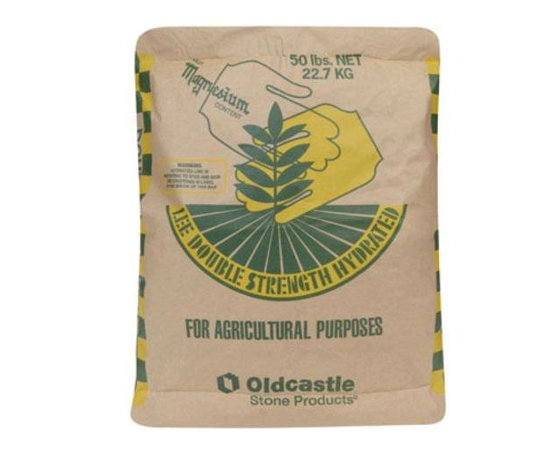
This is excellent hydrated lime. It's a fine white powder and it's going to look great on your home. CLICK THE IMAGE TO ORDER SOME RIGHT NOW.
It’s a cheap material and it’s what was used hundreds and thousands of years ago to make mortars that have stood the test of time. You can mix the hydrated lime with clean sand that will match your existing mortar. The proportions can vary but I’d recommend you mix two parts clean sand to one part hydrated lime.
Strongest Lime Mortar Mix
To create the best mortar mix, add some volcanic ash that’s high in silica content to the mix. I’d mix 1.5 parts sand. 0.5 parts volcanic ash to 1 part hydrated lime.
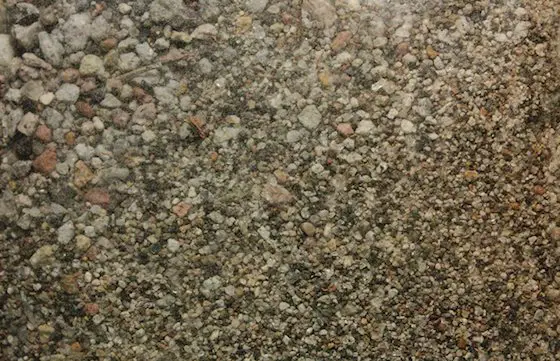
You can buy bags of volcanic ash high in silica content with ease. Here's a great one. CLICK THE PHOTO NOW TO HAVE THIS DELIVERED TO YOUR HOME.
Mix Small Amounts
Only mix as much mortar as can be applied in an hour. You never ever want to add more water to a mortar mix if the mortar starts to get hard. This is called re-tempering the mortar and it fractures the invisible crystals that formed. Once those crystals are broken, they don’t always grow back.
Mortar Consistency
The fresh mortar should have a consistency that resembles a stiff applesauce, not a runny one where liquid collects on the plate. If you add too much water to fresh mortar you simply dilute the amount of lime or cement that’s required to hold the sand together.
Grind Out Old Mortar
To get the best results, I feel you need to grind out some of the old mortar in between the brick. It would be ideal if the new mortar was at least 3/8 of an inch or about 9 mm in thickness. It’s a mind-numbing task to use a grinder equipped with a diamond blade to remove the existing mortar. Wear a mask in case your existing mortar contains silica.
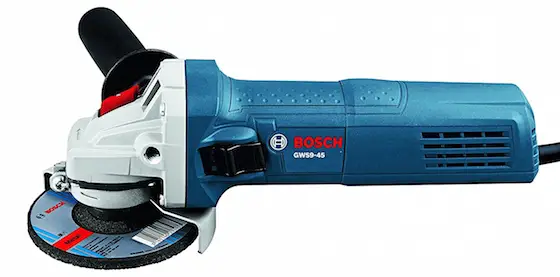
Here's a perfect Bosch grinder that will be easy to handle and will get rid of old mortar FAST. CLICK THE PHOTO NOW TO HAVE THIS TOOL DELIVERED TO YOUR HOME IN DAYS.
Mortar Grinding Video
Here's a fast video that shows how a great grinder with the right diamond blade can QUICKLY cut out old mortar.
Correct Cutting Wheel
Be sure to get the correct diamond blade that's meant to cut out mortar. Usually they're thicker so you just have to make one pass through the mortar joint. Here's a good one:
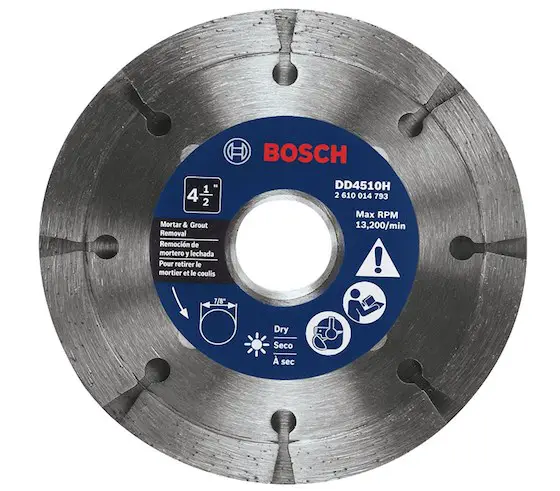
Here's a great diamond blade to put on the Bosch grinder. You want a blade that's at least 1/4-inch wide. CLICK THE PHOTO NOW TO HAVE THIS BLADE DELIVERED TO YOUR HOME IN DAYS.
Get Rid Of Dust
Once you’ve ground out the mortar, you want to rinse off the brick and squirt out the mortar joints to remove any and all dust. Dust will interfere with the growth of the lime crystals as the new mortar tries to bond to the existing mortar and the brick.
Cool Overcast WX
Try to work on a cool overcast day with as little wind as possible. I realize these conditions may be hard to come by along the seashore as wind seems to be a constant. Wind can suck out the water from the new mortar too fast causing it to not become as strong as it might.
Dampen Brick & Old Mortar
Slightly dampen the old mortar joints and brick before you add the new mortar. This water will prevent suction from drawing too much water from the fresh mortar into the old mortar and brick.
You need the new mortar to cure and harden as slow as possible so it attains full strength.
Concave Joints Are Best
Use a curved mortar joint tool to create a slightly concave profile to the new mortar.
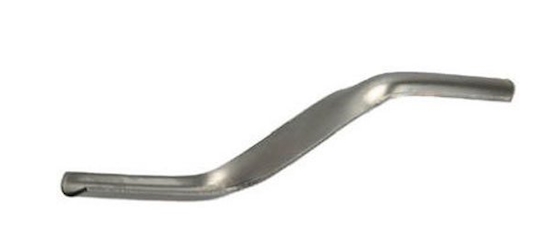
This simple tool creates the best mortar joint that resists water and all other nasty assaults from Mother Nature. CLICK THE PHOTO NOW TO HAVE THIS TOOL DELIVERED TO YOUR HOME IN DAYS.
You often need to tool the mortar within ten minutes before it gets too hard.
CLICK HERE to get FREE AND FAST BIDS from local masons who can tuck point your mortar joints.
Column 1206